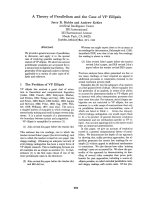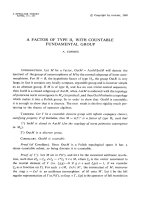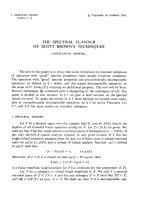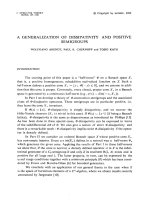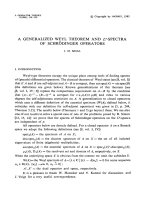Báo cáo toán học: "A note on a problem of Hilliker and Straus" pps
Bạn đang xem bản rút gọn của tài liệu. Xem và tải ngay bản đầy đủ của tài liệu tại đây (111.58 KB, 8 trang )
A note on a problem of Hilliker and Straus
Miroslawa Ja´nczak
Faculty of Mathematics and CS
Adam Mickiewicz University
ul. Umultowska 87, 61-614 Pozna´n, Poland
Submitted: May 20, 2006; Accepted: Oct 23, 2007; Published: Oct 30, 2007
Mathematics Subject Classifications: 06124, 06124
Abstract
For a prime p and a vector ¯α = (α
1
, . . . , α
k
) ∈ Z
k
p
let f (¯α, p) be the largest
n such that in each set A ⊆ Z
p
of n elements one can find x which has a unique
representation in the form x = α
1
a
1
+ · · · + α
k
a
k
, a
i
∈ A. Hilliker and Straus [2]
bounded f (¯α, p) from below by an expression which contained the L
1
-norm of ¯α
and asked if there exists a positive constant c (k) so that f (¯α, p) > c (k) log p. In
this note we answer their question in the affirmative and show that, for large k, one
can take c(k) = O(1/k log(2k)). We also give a lower bound for the size of a set
A ⊆ Z
p
such that every element of A + A has at least K representations in the form
a + a
, a, a
∈ A.
1 Introduction
Let f(p) denote the largest number n such that in any set A = {a
1
, . . . , a
n
} contained in
Z
p
= Z/pZ at least one difference a
i
−a
j
is incongruent to all other differences. Straus [4]
estimated f(p) up to a constant factor, showing that
1
2
log
2
(p −1) + 1 ≤ f (p) <
(2 + o(1))
log
2
3
log
2
p
for all primes p. Hilliker and Straus [2] studied the following natural generalization of
the problem. For a given vector ¯α = (α
1
, . . . , α
k
) ∈ Z
k
p
consider the set of all linear
combinations S = S(¯α, A) = α
1
A + α
2
A + ··· + α
k
A. Let f(¯α, p) be the largest n such
that for any set A ⊆ Z
p
, |A| = n, one can find at least one element which has the unique
representation in S. They proved that
f(¯α, p) ≥
log(p −1)
log(2¯α
1
)
+ 1,
the electronic journal of combinatorics 14 (2007), #N23 1
where ¯α
1
=
k
i=1
|α
i
|. They ask if the L
1
-norm of a vector ¯α can be replaced by
a function which depends only on k, i.e., if f(¯α, p) > c(k) log p?
In the note we settle the above problem in the affirmative (Theorem 1 Corollary 1
below). We also show that our lower bound for f(¯α, p) given in Theorem 1 cannot be
much improved (Theorem 2). In section 3 we find a lower bound on |A ± A| for special
sets A such that every element x ∈ A+ A has at least two different representations a+ a
,
a, a
∈ A. Finally, we give a lower bound for the size of a set A ⊆ Z
p
such that every
element t ∈ A + A has at least K ≥ 2 representations of the form t = a + a
, a, a
∈ A.
Throughout the note ¯α = (α
1
, α
2
, . . . , α
k
) denotes a vector with nonzero integral
components, and l denote the number of different components of ¯α. By log x we always
mean log
2
x, p is a prime, and A is a set of residues modulo p. We set r ·T = {rt : t ∈ T }
but sometimes we shall omit the dot writing for instance α
i
A instead α
i
·A. By S = S(¯α, A)
we mean the set
S = S(¯α, A) = α
1
A + α
2
A + ···+ α
k
A,
and for a natural k we put
kA = A + A + ···+ A
k
.
For x ∈ Z
p
let ν
¯α
(x) = ν
¯α,A
(x) be the number of representation of x in Z
p
in the form
x = α
1
a
1
+ ···+ α
k
a
k
, where a
1
, . . . , a
k
∈ A. For t ∈ R let t denotes the distance from
t to the nearest integer.
Finally, let us mention a simple but important observation that for every x, d
1
, d
2
∈ Z
p
,
d
1
= 0,
ν
¯α,A
(x) = ν
¯α,d
1
A+d
2
(d
1
x + d
2
k
i=1
α
i
). (1)
2 A lower bound for f(¯α, p)
First we present a simple argument which shows that in the inequality
f(¯α, p) ≥
log(p−1)
log(2¯α
1
)
+ 1, proved by Hilliker and Straus [2], one can replace the factor
(log(¯α
1
))
−1
by a constant depending only on k.
Theorem 1. For every ¯α = (α
1
, α
2
, . . . , α
k
) we have
f(¯α, p) ≥
log p
l log 2k
.
Proof. Let A = {a
1
, . . . , a
n
} be a set such that for every element x ∈ S we have ν
¯α
(x) ≥ 2
and |A| = f(¯α, p) + 1. Let T = α
1
A ∪ ··· ∪ α
k
A ⊆ Z
p
. Because of (1) we can and shall
assume that a
1
= 0.
Dirichlet approximation theorem implies that there exists r, 0 < r < p, such that for
every x ∈ T we have
rx
p
≤ p
−
1
|T |−1
.
the electronic journal of combinatorics 14 (2007), #N23 2
Hence, for all α
1
a
1
+ ··· + α
k
a
k
∈ S we have
r(α
1
a
1
+ ··· + α
k
a
k
)
p
≤
rα
1
a
1
p
+ ··· +
rα
k
a
k
p
≤ kp
−
1
|T |−1
.
We shall show that
p
−
1
|T |−1
≥
1
2k
. (2)
Indeed, suppose that the above inequality does not hold and p
−
1
|T |−1
<
1
2k
, so that
r·T ⊆ (−
p
2k
,
p
2k
). Let x
i
∈ α
i
r·A (i = 1, . . . , k). Observe, that for every x
1
+···+x
k
∈ r ·S
we have
x
1
+ ··· + x
k
< x
1
+ ···+ x
k
<
1
2
.
Hence, if m
i
(i = 1, . . . , k) is the largest element in α
i
r · A considered as a subset of
(−
p
2k
,
p
2k
), then, clearly, m
1
+ m
2
+ ···+ m
k
has exactly one representation in S, because
the effect modulo is not possible. Therefore
p
−
1
|T |−1
≥
1
2k
.
Hence
|T | ≥
log p
log 2k
+ 1,
and, since the cardinality of T is at most l(|A|− 1) + 1,
f(¯α, p) + 1 = |A| ≥
log p
l log 2k
+ 1,
completing the proof of Theorem 1.
Since l ≤ k as an immediate consequence of Theorem 1 we get the following result.
Corollary 1. For any ¯α
f(¯α, p) ≥
log p
k log 2k
.
From Theorem 1 it follows that, in particular, for ¯α
(k)
= (1, 1, . . . , 1) we have
f(¯α
(k)
, p) ≥
log p
log 2k
.
Our next result shows that in general this bound cannot be much improved.
Theorem 2. For every ε > 0, k ≥ 2 and every prime p > p
ε
we have
f(¯α
(k)
, p) <
2 + 3ε
log(2k − 1)
log p + 3.
the electronic journal of combinatorics 14 (2007), #N23 3
Proof. Our construction of a set A is a straightforward generalization of the one presented
in [2]. Put
R = {0, ±1, ±2, . . . , ±z
k
},
where
z
k
=
k(2k −1)
m
− 1
k − 1
and
2k
ε
< m < log
2k−1
ε
k
log
2k−1
p
. Thus, the set (k −1)R consists of all residues modulo
k(2k −1)
m
. We recursively define a descending sequence a
1
, a
2
, . . . , a
l
setting
a
1
= (p −r)/k, p ≡ r mod k(2k −1)
m
, r ∈ (k − 1)R,
a
i+1
=
a
i
/(2k − 1) if a
i
≡ 0 mod (2k − 1)
(a
i
− r
i
)/k if a
i
≡ 0 mod (2k − 1),
(3)
where r
i
≡ a
i
mod k(2k − 1)
m
. The last element a
l
of this sequence satisfies
a
l
≥ z
k
+ 1, a
l+1
∈ R. (4)
Define
A = R ∪ {±a
1
, . . . , ±a
l
}.
We need to show that every element x ∈ S has at least two different representations. It
is clear that if z = a
1
+ ···+ a
i
+ ···+ a
j
+ ···+ a
k
with a
i
= a
j
, then z = a
1
+ ···+ a
j
+
··· + a
i
+ ··· + a
k
is another representation of z. It remains to show that each element
ka, where a ∈ A, has at least two representations in S. If a = 0 then it is indeed the case,
since
ka = 0 + ···+ 0 = 1 + (−1) + 0 + ···+ 0.
For 0 < a < z
k
we have
ka = (a − 1) + (a + 1) + a + ··· + a
k−2
.
Finally, if a = z
k
, then by (3) and (4)
z
k
+ 1 ≤ a
l
≤ (2k − 1)z
k
.
Hence
(k − 1)z
k
− 1 ≥ ka − a
l
≥ −(k − 1)z
k
.
Observe that ka − a
l
∈ (k − 1)R. So, there exist b
1
, . . . , b
k−1
∈ R such that
ka = a
l
+ b
1
+ ··· + b
k−1
.
Now we show that every element ka
j
has at least two representations in S. If j ≥ 2, then
by construction of the sequence we have either a
j
= a
j−1
/(2k −1), or a
j
= (a
j−1
−r
j−1
)/k.
If a
j
= a
j−1
/(2k − 1), then (2k − 1)a
j
= a
j−1
and
ka
j
= a
j−1
− (k − 1)a
j
= a
j−1
+ (k − 1)(−a
j
).
the electronic journal of combinatorics 14 (2007), #N23 4
If a
j
= (a
j−1
− r
j−1
)/k, then
ka
j
= a
j−1
+ (−r
j−1
)
∈(k−1)R
.
If j = 1 then ka
1
has the following two representations in S:
a
1
= (p −r)/k, where r ≡ p (mod k(2k − 1)
m
) , and r ∈ (k − 1)R,
ka
1
= p − r ≡ −r (mod p) .
It means that
ka
1
= a
1
+ ··· + a
1
k
= 0 + (−r)
∈(k−1)R
.
Finally, we estimate the cardinality of A. Note that
|A| = 2l + 2z
k
+ 1 = 2l + 2
k(2k −1)
m
− 1
k − 1
+ 1 < 2l + 2
k(2k −1)
m
k − 1
+ 3.
Observe that a
i+1
< a
i
for all i and a
i+1
= a
i
/(2k−1) for all except at most one out of every
m+1 consecutive terms a
j
, a
j+1
, . . . , a
j+m
. We have also a
j+1
≤ a
j
/k if a
j+1
= (a
j
−r
j
)/k,
where r
j
≡ a
j
(mod k(2k − 1)
m
), r
j
∈ (k − 1)R. Thus
a
j+m+1
< k
−1
a
j
(2k − 1)
−m
and
k(2k −1)
m
k − 1
≤ a
l
< pk
−l−1
m+1
(2k − 1)
1−
lm
m+1
.
Hence
l <
1
m
1 − m
2
+ (m + 1)
log p
log(2k − 1)
< (1 + 1/m)
log p
log(2k − 1)
.
Consequently,
|A| < 2
1 + 1/m
log p
log(2k − 1)
+ 2
k(2k −1)
m
k − 1
+ 3
< 2(1 + ε/(2k))
log p
log(2k − 1)
+ 2ε/(k − 1)
log p
log(2k − 1)
+ 3
=
2 +
3k − 1
k(k −1)
ε
log p
log(2k − 1)
+ 3
≤
2 + 3ε
log p
log(2k − 1)
+ 3
for
2k
ε
< m < log
2k−1
ε
k
log
2k−1
p
and k ≥ 2.
Next result shows that for each α the order of magnitude of f(¯α, p) is at most log
2
p.
This improves the upper bound for f(¯α, p) in [2].
the electronic journal of combinatorics 14 (2007), #N23 5
Theorem 3. For every ¯α = (α
1
, . . . , α
k
) we have
f(¯α, p) ≤ 4 log
2
p.
Proof. Observe that if ¯α = (1, α
2
) and ¯α
= (1, α
2
, α
3
, . . . , α
k
), then f(¯α, p) ≥ f(¯α
, p).
Let S be a set such that for every element x ∈ S + S we have ν
(1,1)
≥ 2 and |S| ≤ 2 log p.
Let a
1
, a
2
∈ A = S + α
2
S. Then
a
1
+ α
2
a
2
= (s
1
+ α
2
s
2
) + α
2
(s
3
+ α
2
s
4
)
= s
1
+ α
2
(s
2
+ s
3
) + α
2
2
s
4
= s
1
+ α
2
(s
2
+ s
3
) + α
2
2
s
4
= (s
1
+ α
2
s
2
) + α
2
(s
3
+ α
2
s
4
)
= a
1
+ α
2
a
2
for some a
1
, a
2
, a
1
, a
2
∈ A and s
1
, s
2
, s
3
, s
4
, s
2
, s
3
∈ S. Thus
f(¯α, p) ≤ |A| ≤ |S|
2
≤ 4 log
2
p.
3 The cardinality of sumsets
In this section we estimate the cardinality of A − B, where A is such that every element
of A + A has at least two representations, and B is an arbitrary subset of Z
p
. The main
result of this section can be stated as follows.
Theorem 4. If A ⊆ Z
p
and for any element x ∈ A + A we have ν
(1,1)
(x) ≥ 2, then for
any B ⊆ Z
p
|A − B| ≥ |B|
log p
log 12
− |B|
.
Proof. Our argument is based on the following result of Ruzsa [3].
Lemma 1. Let A, B ⊆ G be finite sets and G be an abelian group. Then there exists
a set X ⊆ G such that B ⊆ X + A − A and |X| ≤
|B−A|
|A|
.
Let X be a set whose existence is guaranteed by Lemma 1, i.e.,
|X| ≤
|A − B|
|B|
and A ⊆ X + B − B. (5)
By Dirichlet’s theorem applied to the set X ∪ B there is an integer 0 < r < p such that
for any element z ∈ X ∪B
rz
p
≤ p
−
1
|X|+|B|
.
the electronic journal of combinatorics 14 (2007), #N23 6
For every a ∈ A there exist b
1
, b
2
∈ B and x ∈ X such that a = x + b
1
− b
2
. Hence
ra
p
≤
rx
p
+
rb
1
p
+
rb
2
p
≤ 3p
−
1
|X|+|B|
.
Moreover, arguing as in the proof of Theorem 1 (cf. (2)), we get
3p
−
1
|X|+|B|
≥
1
4
.
Thus
|X| ≥
log p
log 12
− |B|,
and, from (5),
|A − B| ≥ |B||X| ≥ |B|
log p
log 12
− |B|
.
Corollary 2. If A ⊆ Z
p
and for any element x ∈ A + A we have ν
(1,1)
(x) ≥ 2, then
|A ± A| ≥
log p
2 log 12
2
.
Proof. Pick any set B ⊆ ±A with |B| =
log p
2 log 12
and apply Theorem 4 for the sets A
and B.
Let f
K
(p) be the largest n such that for any set A ⊆ Z
p
with at most f
K
(p) elements
there exists at least one element in A +A with less then K representations. As a corollary
from Theorem 4 we obtain the following lower bound for f
K
(p).
Corollary 3. For every K ≥ 2 we have
f
K
(p) ≥
√
K
log p
2 log 12
− 1.
Proof. Let us assume that A ⊆ Z
p
, for each element x ∈ A+A we have ν
(1,1)
(x) ≥ K ≥ 2,
and |A| = f
K
(p) + 1. By Corollary 2 we get
|A + A| >
log p
2 log 12
2
. (6)
Since
K|A + A| ≤
t∈A+A
ν
(1,1)
(t) = |A|
2
,
it follows that
|A|
2
K
≥ |A + A|. (7)
the electronic journal of combinatorics 14 (2007), #N23 7
From (6) and (7), we get
f
K
(p) + 1 = |A| ≥
√
K
log p
2 log 12
,
and so
f
K
(p) ≥
√
K
log p
2 log 12
− 1 .
References
[1] J. Browkin, B. Divi
ˇ
s, A. Schinzel, Addition of sequences in general fields,
Monatshefte f¨ur Mathematik 82 (1976), 261–268.
[2] D. L. Hilliker, E. G. Straus, Uniqueness of linear combinations (mod p), Journal
of Number Theory 24 (1986), 1–6.
[3] I. Z. Ruzsa, An analog of Frieman’s theorem in groups, Asterisque 258 (1999),
323–326.
[4] E. G. Straus, Differences of residues (mod p), Journal of Number Theory 8 (1976),
40–42.
the electronic journal of combinatorics 14 (2007), #N23 8
